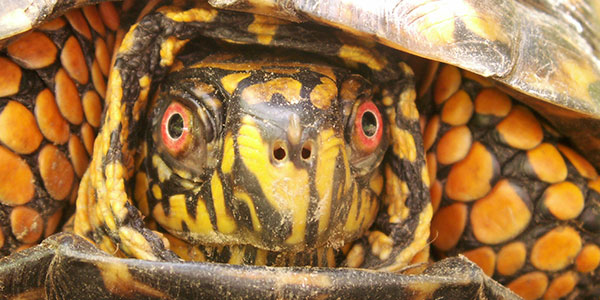Eastern box turtles are not dangerous; they pose no threat to humans. Eastern box turtles are harmless and gentle creatures, known for their unique patterns and colors on their shells.
These turtles are native to the eastern regions of the United States, primarily found in forests, wetlands, and meadows. Their diet consists of plants, berries, insects, and small vertebrates. Unlike some aggressive reptiles, box turtles have a passive nature and typically retreat into their shells when they feel threatened.
They are not venomous and do not possess any harmful capabilities, making them safe to observe and interact with in their natural habitats. So, if you encounter an eastern box turtle, you can appreciate their beauty and uniqueness without worry.

Credit: nationalzoo.si.edu
Understanding Eastern Box Turtles
Eastern Box Turtles are fascinating creatures known for their distinct appearance and behavior.
Appearance And Behavior
Eastern Box Turtles boast a domed shell that ranges in color from olive to brown, adorned with yellow or orange markings. They have powerful jaws and a hinge mechanism that allows them to close their shell tightly for protection. These turtles are terrestrial, spending most of their lives on land. They can usually be found in woodlands, meadows, and marshy areas.
Natural Habitat
Eastern Box Turtles are native to Eastern and Central United States. They prefer environments with moderate temperatures and ample sources of water. Leaf litter and decaying vegetation provide an ideal habitat for them, as they rely on these for food, shelter, and reproduction.
Diet And Reproduction
Eastern Box Turtles are opportunistic omnivores, meaning they feed on a variety of plants and animal matter. They consume fruits, mushrooms, insects, earthworms, and even carrion. When it comes to reproduction, female turtles lay their eggs in nests dug in soft soil during the summer months. These eggs then hatch in about 2-3 months, resulting in tiny baby turtles.

Credit: www.chesapeakebay.net
Potential Dangers Of Eastern Box Turtles
Eastern box turtles, although fascinating creatures with their distinctive appearance and gentle nature, can pose certain risks. It’s essential to be aware of the potential dangers they may bring:
Bacterial Infections
Eastern box turtles can carry various bacteria, including Salmonella, which can be harmful, especially to vulnerable individuals such as young children, the elderly, or those with weakened immune systems. Direct contact or mishandling these turtles without proper hygiene measures can lead to infections.
Parasites and Diseases
Just like any wildlife species, Eastern box turtles may harbor parasites and diseases. These can be transmitted through contact, and while the risk is relatively low, it’s important to handle these reptiles with care and maintain proper hygiene to minimize any potential health issues.
Allergic Reactions
Some individuals may experience allergic reactions when in proximity to Eastern box turtles. These reactions can range from mild irritation to severe allergies. It’s advisable to consult with a healthcare professional if you have known allergies or experience any unusual symptoms after interacting with these turtles.
Mitigating Risks And Ensuring Safety
Mitigating risks and ensuring safety is essential when it comes to dealing with Eastern Box Turtles. These turtles are not dangerous, but proper precautions should be taken to protect both the turtles and humans from harm.
Handling Guidelines
When interacting with Eastern Box Turtles, it’s crucial to follow proper handling guidelines to mitigate any potential risks and ensure the safety of both yourself and the wildlife. This includes practicing proper hygiene to prevent the spread of pathogens.
Always remember to wash your hands thoroughly before and after handling the turtles. This simple step can prevent the transmission of any harmful bacteria or parasites that may be present on their shells or skin.
Respecting the wildlife is another important aspect of handling Eastern Box Turtles. These creatures are an integral part of the ecosystem and must be treated with care and caution. Avoid disturbing their natural habitats and try to observe them from a respectful distance.

Credit: www.phipps.conservatory.org
Conclusion
While it is important to exercise caution when encountering Eastern box turtles, they are generally not dangerous to humans. It is crucial to respect their natural habitat and avoid handling them unnecessarily. Educating ourselves about these fascinating creatures can help foster coexistence and protect their population.
By practicing responsible behavior and supporting conservation efforts, we can ensure the safety of both humans and Eastern box turtles in our shared environment.






Leave a Reply